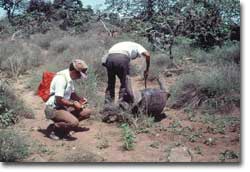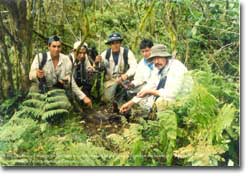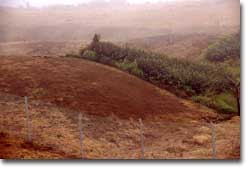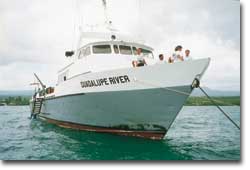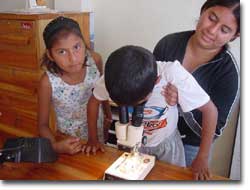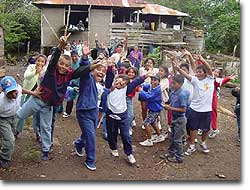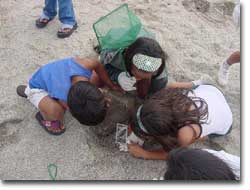Navigation
The Galapagos Conservation Fund (GCF)
"Our intention in developing the Galapagos Conservation Fund was to show that through partnerships and cooperation, tourism could be a significant force for conservation. We fundamentally believe that dialogue and cooperation between the tourism industry, local resource managers, and supporting non-profit organizations can result in programs and projects that benefit the destinations, the businesses, and the experience of the visitors."
Location:
Galapagos Islands, Ecuador
Problem Overview:
Tourism is one of the most important industries in Galapagos, if not the most important. 60,000 visitors come to Galapagos every year, and all leave with the understanding that Galapagos is an extraordinary place on this planet. Yet, there has been surprisingly little integration of conservation issues into the visitor experience, and the tourism industry plays an inadequate role in the support of conservation of Galapagos. The links between tourism and conservation in Galapagos are vital to the future protection of its unique flora and fauna.
The Galapagos Conservation Fund
I. Introduction
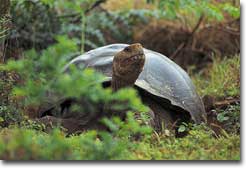 |
| Galapagos Tortoise |
When Lindblad Expeditions stationed its 80-passenger expedition vessel in the Galapagos Islands in May 1997, there was a glaring lack of communication and integration between the tourism industry and the institutional conservation of the islands. Sixty thousand people visited the islands each year and learned about the flora and fauna, yet there was very little information about conservation needs of the islands or available mechanisms to support conservation. Conservation communication was not included in the training of Park guides, there was very little support for conservation from the tourism industry, and tourism was largely viewed as an adversary to conservation in Galapagos. Tourism was equally disconnected from the local communities of the islands.
Our intention in developing the Galapagos Conservation Fund was to show that through partnerships and cooperation, tourism could be a significant force for conservation. We fundamentally believe that dialogue and cooperation between the tourism industry, local resource managers, and supporting non-profit organizations can result in programs and projects that benefit the destinations, the businesses, and the experience of the visitors.
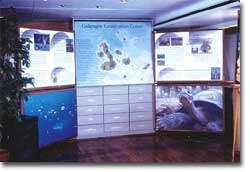 |
| Galapagos Conservation Center on board M/N Polaris |
The primary element of the Galapagos Conservation Fund is an on-board conservation communication strategy to inspire visitors to actively support prioritized conservation projects in Galapagos. The GCF now reliably raises an average of $200,000 per year from visitors on the 80-passenger Polaris. However, the most significant accomplishments of the GCF derive from the ongoing interaction and dialogue between Lindblad Expeditions, GNP, and CDRS. Centered around project management, the relationship has since given rise to local capacity-building programs, improved interpretive mechanisms, development of guide-training programs that incorporate conservation messages, increased communications and interpretive infrastructure in the Park and Station, and increased interaction between tour operators and Park officials and Station researchers. Most importantly, there has been an undeniable increase in the interest and involvement of tour operators in the support of conservation in Galapagos, with numerous tour operators establishing their own conservation, environmental education, and training initiatives.
II. Important Components of the Galapagos Conservation Fund Concept
All contributions to the GCF are allocated by an authoritative and objective board of internationally respected and locally knowledgeable conservation leaders, acting in the interest of the entire region rather than for one organization or cause.
GCF project allocations require joint proposals and agreement by both the Galapagos National Park and the Charles Darwin Research Station.
All contributions are made by visitors to Galapagos, with the understanding that contributions are allocated by the GCF based on determined conservation priorities of the region.
100% of the contributions go to the projects designated by the GCF advisory board.
All administrative costs of the GCF and the functioning of the GCF advisory board are paid for by Lindblad Expeditions.
Lindblad Expeditions provides a matching incentive by offering a $250 travel voucher toward any future booking for every donation of $250 or more.
Lindblad Expeditions believes that it makes good business sense for any travel company to invest in its own future by actively supporting the long-term health and preservation of the resources upon which it depends, through the conservation of its destinations.
The GCF endeavors to create a working model of communication to visitors and channeling of contributions that could be adapted by other travel companies interested in encouraging visitor support.
III. Projects supported by the GCF
Through joint proposals by Galapagos National Park (GNP) and Charles Darwin Research Station (CDRS), and approval by the advisory board, ongoing GCF funding is applied toward the following projects. Project descriptions are adapted from annual reports to Lindblad Expeditions from GNP and CDRS.
1) Adopt-an-Island program for the island of Santiago
Galapagos National Park field work; monitoring tortoises. The GCF has committed to the long-term support and implementation of a restoration plan for the island of Santiago. The essence of the plan is to eradicate feral pigs, goats and rats, and reestablish endangered endemic plants of the island. Feral pigs, which eat the eggs of tortoises and other native animals, are much more easily eradicated while the vegetative cover is destroyed by the feral goats. Once the pigs are eradicated, work can begin on eradicating the goats, so that the vegetation can return. Endangered native plants are being cultivated in anticipation of a programmed reintroduction after successful goat eradication.
A. Eradication of feral pigs from the island of Santiago
The last pig killed in Adopt-an-Island pig eradication The pig eradication campaign on Santiago Island is very close to public declaration of success. Support from the Galapagos Conservation Fund /Lindblad Expeditions has been critical in achieving advanced stages of pig eradication. The last pig shot to date was in May 2000, and after continuous widespread baiting, one other pig was detected and killed in November 2000. Beyond this observation, no other trace of pigs has been noted. In 2001, the Isabela Project will continue its intensive monitoring of the island using baits (goat carcasses) placed in a GIS/GPS assisted equidistant pattern, separated from each other by 500 meters. In 1997, the project imposed upon itself a need for 18 months of consecutive, intensive pig-free monitoring before the island could be publicly declared pig free. Should no further pigs or signs of pigs be detected, the declaration would be made in May 2002. The confidence level among hunters is very high. Santiago Island will be the largest island ever, in the entire world, from which pigs will have been successfully eradicated.
B. Re-establishment of native plant species
Protection and restoration of endemic plant species on Santiago. Activities by the Department of Botany on Santiago include an ecological study of the rarest Galapagos plant (Scalesia atractyloides, endemic to Santiago) and its relative S. stewartii, which will be completed during 2001. The study of Scalesia atractyloides will hopefully contribute information necessary for a cultivation and programmed re-introduction. Monitoring of the vegetation on small islets will continue, in conjunction with plans to eradicate introduced rats and introduce endemic rats on small islets. This will enable us to determine the effect of the two rat species on plant species and communities. Finally, it is planned to commence a research project examining the recuperation of the native vegetation following goat control and imminent removal.
Long-term monitoring of the effects of goats, and planning for vegetation restoration following eventual goat eradication, has been under way since 1995. Permanent plots inside and outside fenced areas are monitored once every 18 months (alternate wet and dry seasons), to assess differences caused by goat grazing and check regeneration within the protected sites. The latest monitoring trip took place in November 2000. During this trip, new transects were established in the areas that were newly protected when many of the fences were enlarged two years ago. The new sites are already regenerating well: a promising sign that the protected sites will serve as valuable sources for vegetation re-establishment after the goats have been removed.
2) Support of Patrolling Efforts and Physical Maintenance of Galapagos National Park’s patrol boat P/V Guadalupe River for protection of the recently expanded marine reserve.
Galapagos National Park's patrol boat Guadalupe River, for the Marine Reserve project Galapagos National Park Service’s group of patrol boats consists of two large boats, the Guadalupe River and the Sirinian, and five small boats: Sea Ranger 1, Sea Ranger 2, Sea Ranger 4, Sea Ranger 6, and Virgen del Rocio. The maintenance and operation for these boats to carry out effective patrolling is costly but vital to put a stop to illegal fishing within the Marine Reserve. The boats also assist in environmental education campaigns to help educate the fishing communities and involve them in our conservation efforts. From July to December 2000 the Galapagos National Park Office’s Marine Recourses Unit which manages the Galapagos Marine Reserve carried out the following important activities:
- Regular patrolling, monitoring and logistical support trips
- Dry dock and maintenance of the P/V Guadalupe River
- Rescue and support trips for the GNP personnel as part of the work to protect the GMR
- Lobster catch monitoring
- Continuing the coastal clean-up program
The patrolling and monitoring trips have been continuous. The patrolling unit’s principal help is the Guadalupe River, but they are often backed-up by smaller vessels, fast launches some of which can hold up to 4 crew members. The Guadalupe River has made 20 trips of varied lengths, lasting from a few days to two weeks. The boat completed its activities on October 16, when it entered dry dock in Guayaquil, Ecuador. The Guadalupe River has never been in better condition since it arrived in Galapagos, thanks to the support received from Lindblad Expeditions and the Barbara Delano Foundation.
3) Environmental Education
A. Establishment of environmental education centers for local populations.
Scenes from an environmental education program supported by GCF Since the program started, teacher training has allowed more than 230 teachers from the three most populated islands to learn more about using environmental themes for education, making educational projects, and producing didactic material. The Environmental Education Centers (EEC) have offered various campaigns and programs to stimulate awareness about the main environmental problems of the islands and to promote local participation in conservation. The centers on the islands of Isabela, San Cristobal, and Santa Cruz have more than 15,000 visitors per year. Moreover, they have published two books from the ten-part series “Galápagos, un mundo mágico” (Galapagos, a magical world) for students aged five to fourteen.
The EEC program is complemented by 28 conservation projects from the local community (FALC) and the program for training teachers on board, which has involved 46 teachers since it started. These successes would not have been possible without the support of Lindblad Special Expeditions.
B. A university scholarship in biology or environmental sciences for a Galapagos student.
This funding financed the scholarship of Diógenes Aguirre, a student from the islands, who is studying Biology in the Central University of Quito. He has performed well in his studies and he has been an active volunteer in the Station during his vacations, mostly in field activities related to the Ornithology Area.
For the year 2001 scholarships have been granted to 5 more students from Galapagos. Lindblad Expeditions’ funds will be used to finance the scholarships of three of these students. Each scholarship covers the cost of university tuition fees, a contribution for food and accommodation in the continent, medical insurance, and airplane tickets twice a year for the vacation period. The budget for each scholarship student is approximately $3,200 each year, for the 5 years of undergraduate studies.
This Program supports young Galapagos students that have demonstrated a strong interest in biology and conservation. Our (Charles Darwin Research Station) hope is that they will finish their education in order to become the future professionals who will work for the conservation of Galapagos.
C. Teachers on board Program
In coordination with the Provincial Education Office and the National Office of Professional Improvement (DINAMEP), cruises for teachers around the Galapagos islands are being offered on Lindblad Expeditions’ 80-passenger vessel M/N Polaris as part of the formal training process of the DINAMEP-FCD agreement.
Objectives of the Teachers On Board program are:
1) To experience the Galapagos Islands and Galapagos National Park, which most teachers never see beyond their own communities.
2) To learn about the nature of the visitors to Galapagos, and the reasons that people come to visit the Galapagos Islands.
3) To learn about the role that tourism can play in environmental education and conservation support in the Galapagos Islands.
4) To take the knowledge and experience they gain and bring it back into the classroom to teach to their students.
The change is obvious, teachers are more committed and conscious of their task of protecting the environment, and more importantly, conscious of their task of shaping integral beings for the world. The program is now run in conjunction with another tour operator, and 44 teachers had participated in the program as of November 2000.
4. A “small grants” fund that encourages locally-initiated conservation projects.
Since the FALC Program (Funds for Local Conservation Action) started, 28 projects have been developed with the support of Lindblad Expeditions. During 2000, 17 local community conservation projects were carried out. These include the planning and implementing of a native garden and vegetable garden in two local schools; development of didactic games for Santa Cruz Schools and support for the coastal clean-up campaign organized by the Santa Cruz Guides Association. The Marine Reserve and introduced species continue to be the central themes of projects proposed by the community. This experience has a wide effect and presently is generating a healthy competition among the participants to demonstrate their abilities and skills. The teachers, for example, thanks to FALC, have been able to make their dreams reality by producing their own didactic material for students and themselves.
Technical support to develop and present proposals has been strengthened. However, during 2000 there were fewer proposals than anticipated, so for this reason in 2001 a series of actions are planned to stimulate the development of local initiatives for conservation:
- To run a campaign to promote FALC through radio, television, and the press.
- To give presentations about FALC to various sectors, through workshops organized for groups such as agriculture and fishing.
To systemize application and implementation procedures for the projects and to develop forms.
5) Funding for invertebrate research and the establishment of an invertebrate collection.
The purpose of this project is to establish a comprehensive collection of the invertebrates of the Galapagos. Having an accessible and comprehensive collection of invertebrates will enable us (CDRS) to determine what species are found on the islands and alert us to new introductions. In 1999, the creation of an invertebrate collection was sponsored in part by Lindblad Expeditions. During this year the museum infrastructure has been improved and a database system designed. In 2000 the Invertebrates program has made efforts to organize and increase the reference collection of Invertebrates at the CDRS, and also to start control programs for two introduced species, Simulium bipunctatum and Wasmannia auropunctata. Entomologists also finished testing the feeding range of Rodolia cardinalis in order to evaluate the possibility of using this insect to control the cottony cushion scale, Icerya purchasi.
6) An emergency fund for unforeseen needs
An emergency fund is maintained so that the Park and Station have access to immediate cash supplies for unforeseen needs. These funds have been used in the past to investigate an outbreak of disease amongst giant tortoises on Isabela, repairing damage to a fence that protected endemic plants from feral goats, monitoring of the effects of the El Nino year, and other needs that result from unforeseen events.
IV. Advisory Board
The GCF Advisory Board is an independent, advisory and technical body with no legal status.
Miguel Cifuentes—Current President of the Charles Darwin Foundation and WWF regional representative for Central America; former Director of Galapagos National Park.
Craig MacFarland—Former Director of Charles Darwin Research Station; former President of Charles Darwin Foundation; international conservation and resource management consultant; current board member of Charles Darwin Foundation, Inc.
Tui de Roy—Galapagos native, wildlife photographer, expedition leader, and former Galapagos National Park guide.
The Goal is to support Galapagos conservation efforts by:
- Fostering visitor support for conservation in Galapagos
- Leveraging visitor support to attract new sources of funding
- Building partnerships with and between other stakeholders in Galapagos conservation
- Encouraging Galapagos conservation initiatives from private enterprises
The Basic Principles are:
- Charles Darwin Foundation (CDF) and Galapagos National Park Service (GNPS) are the existing conservation authorities in Galapagos and therefore all funds will be channeled through these two institutions
- All projects should be jointly endorsed by CDF and GNPS
- The active participation of CDF and GNPS in communications and other activities is essential to the overall success of Galapagos Conservation Fund (GCF)
- All potential funding must augment and not compete with existing funding opportunities
- In-kind donations will not be encouraged. Exceptionally valuable in-kind donations should be directed to CDF/GNPS mechanism
The responsibilities of the GCF Board are:
- Deciding on funding disbursement
- Evaluating project proposals and project implementation
- Advising the development of Memorandums of Understanding with key partners
- Electing a rotating point person in charge of communications and establishing the agenda for the following meeting
- Advise Lindblad Expeditions on the configuration of the Board
The responsibilities of Lindblad Expeditions are:
- Raise funds and create the best atmosphere for fundraising
- Function as the secretariat (produce and distribute minutes, maintain files, logistic support)
- Legally represent GCF
- Receive, record and transfer the funds
- Provide administrative funding for the operation of the Board
- Develop and implement Memorandums of Understanding with the advice of the GCF Advisory Board
Joint responsibilities of Lindblad Expeditions and GCF Board:
- Communicating externally about GCF conservation initiatives and accomplishments
- Developing fundraising strategies in collaboration with relevant partners
- Building mutually productive lines of communication and collaboration with other stakeholders
V. The Conservation Communication Strategy
As a tour operator with an emphasis on environmental interpretation, our communications with our guests is of the utmost importance. We felt that the communication of conservation issues for the purpose of inspired engagement in conservation support demanded an organized communication strategy. For this purpose, we contracted the internationally recognized author of “Environmental Interpretation”, Dr. Sam H. Ham from the University of Idaho’s Department of Resource, Recreation and Tourism. Dr. Ham introduced a methodology and developed an integrated communication strategy based on delivering a series of coordinated messages through a variety of available oral and printed media over the course of the visitor experience.
Primary messages are those things that people need to internalize and incorporate into their thinking in order to establish their beliefs. Supporting messages work to break down misconceptions, destroy negative or contradicting messages that people may get, and overcome their beliefs in negative consequences of their action.
Primary (P-) Messages
P1: “Galapagos is unique in the world.”
P2: “All eyes are on the Galapagos.”
P3: “In the end, it will be the passion and insistence of the visitor that will ensure the preservation of the Galapagos Islands”
P4: “Lindblad Expeditions has championed the creation of the Galapagos Conservation Fund and has committed its own resources to the cause. It invites its own guests to join the cause to protect the “World’s Natural Jewel”
Secondary (S-) Messages
S1: “Galapagos is threatened by the introduction of aggressive and well adapted exotic species that don’t belong here. These species either kill or out-compete Galapagos’ native and endemic species.”
S2: “Illegal commercial fishing is threatening the rich marine ecosystem on which almost all Galapagos wildlife depends.”
S3: “Current funding falls far short of the capital required to manage and protect the Galapagos Islands.”
S4: “Donated funds go straight to a special Galapagos Conservation Fund administered jointly by the Charles Darwin Foundation and Galapagos National Park.”
S5: “All of the funds go directly to new or ongoing conservation projects.”
A matrix was then developed that listed all of the available media of oral and visual communication to visitors over the course of their experience. We then plotted the appropriateness of each message through each communication medium, based on the visitor experience at that point in their expedition. Some messages are more appropriately delivered at specific points in the guests’ overall experience, while some messages may be too strong to develop early on and must be slowly introduced as a person develops an emotional connection to an experience. Therefore, great care had to be taken in the mapping out of the messages and their delivery.
We then began developing the materials needed to communicate the messages in an organized manner that would be consistent from week to week, and the necessary training of field staff to support the implementation of the strategy. Though complete implementation took some time, the development of an organized communications strategy unquestionably resulted in consistent responses from our guests. This has translated into an average of about $4000 per week in steady support for Galapagos conservation.
VI. Current Status
The GCF continues to operate with full support of the Lindblad Expeditions field staff and very little annual maintenance. Projects are proposed and renewed annually by the Park and Station, and approved by the GCF advisory board. The advisory board meets an average of once a year. Donations average $200,000 per year.
 Teachers Aboard program. |
There is a great deal of other interaction between Lindblad Expeditions and the Park and Station. The Polaris hosts researchers, officials, and guests of the Park and Station, and provides occasional transportation for researchers. The Teachers Aboard program establishes regular interaction with the local schools, and provides opportunities for teachers and students to work with crew members and take advantage of other opportunities.
The Park and Station have increased their staff infrastructure for interpretation, external communications, and guide-training are now working with other tour operators on support campaigns. A participatory workshop will be held in October 2001 for tour operators with the goal of showcasing examples of how the tourism industry can further support conservation and environmental education in Galapagos.
Fully implemented and operational on a consistent, year-round basis since July 1998.
The performance of the GCF and the communication strategy is continually monitored. Efforts are currently underway to communicate the processes and successes of the GCF and other tourism/conservation initiatives to other tour operators in Galapagos through a participatory workshop in October 2001.
1) Case study developed by Business Enterprises for Sustainable Tourism (B.E.S.T.)
contact:
Michael Seltzer, Director
The Conference Board, 845 Third Avenue
New York, NY 10022
tel: 212-339-0335
fax: 212-836-9718
email: best@conference-board.org
website: http://www.sustainabletravel.org/
2) Case study on GCF communication strategy, to be published in forthcoming book on environmental interpretation by Dr. Sam Ham.
contact:
Dr. Sam H. Ham
Professor and Director
University of Idaho
Center for International Training & Outreach (CITO)
College of Natural Resources, Department of Resource Recreation and Tourism
Moscow, Idaho 83844-1139 USA
fax: 208-885-6226
tel: 208-882-5128
email: sham2@turbonet.com
website: www.uidaho.edu/cfwr/rrt/
Submitted by:
Tom O’Brien
mailto:tomo@expeditions.com
Lindblad Expeditions
1415 Western Avenue, suite 700
Seattle, WA 98199
(206)-624-7750
tel: 1-800-EXPEDITION
fax: 1-212-265-3770
email: explore@expedition.com
For additional information:
Eliecer Cruz
Director, Galapagos National Park
Parque Nacional Galapagos
Puerto Ayora, Isla Santa Cruz
Galapagos Islands, Ecuador
Tel: 593-5-526189/526511
Fax: 593-5-526190
email: png@ga.pro.ec
Robert Bensted-Smith
Director, Charles Darwin Station
Puerto Ayora, Santa Cruz
Galapagos Islands, Ecuador
tel: 593-5526-147/148,
fax: 593-5527-013/014
email: mailto:tomo@expeditions.com
Roz Cameron
Communications Director
Charles Darwin Research Station
Puerto Ayora, Santa Cruz
Galapagos Islands, Ecuador
tel: 593-5526-147/148,
fax: 593-5527-013/014
email: cdrs@fcdarwin.org.ec
Johannah Barry
Charles Darwin Foundation, Inc.
407 N. Washington Street,Suite 105
Falls Church, VA 22046 U.S.A.
e-mail: darwin@galapagos.org;
tel: +1 703 538 6833
Craig MacFarland
GCF Advisory Board
Box 207, 996 McLeod Rd.
Arlee, MT 59821
Tel: 406.726.3974
email: riverbottom@blackfoot.net
Tui de Roy
GCF Advisory Board
Patons Rock Beach, Takaka, Box 161,
Golden Bay, N E W Z E A L A N D
Phone: +64 3 525 8370.
Fax: +64 3 525 8370.
E-mail: roving.tortoise@voyager.co.nz
Michael Seltzerv
Director, Business Enterprises for Sustainable Tourism (B.E.S.T.)
The Conference Board
845 Third Avenue, New York, NY 10022
tel: 212-339-0335
fax: 212-836-9718
email: best@conference-board.org
Information Date: 2001-08-07
Information Source: Tom O’Brien, Director of Environmental Affairs, Lindblad Expeditions
- Login to post comments

Search
Latest articles
Agriculture
- World Water Week: Healthy ecosystems essential to human health: from coronavirus to malnutrition Online session Wednesday 24 August 17:00-18:20
- World Water Week: Healthy ecosystems essential to human health: from coronavirus to malnutrition Online session Wednesday 24 August 17:00-18:20
Air Pollution
- "Water and Sanitation-Related Diseases and the Changing Environment: Challenges, Interventions, and Preventive Measures" Volume 2 Is Now Available
- Global Innovation Exchange Co-Created by Horizon International, USAID, Bill and Melinda Gates Foundation and Others
Biodiversity
- It is time for international mobilization against climate change
- World Water Week: Healthy ecosystems essential to human health: from coronavirus to malnutrition Online session Wednesday 24 August 17:00-18:20
Desertification
- World Water Week: Healthy ecosystems essential to human health: from coronavirus to malnutrition Online session Wednesday 24 August 17:00-18:20
- UN Food Systems Summit Receives Over 1,200 Ideas to Help Meet Sustainable Development Goals
Endangered Species
- Mangrove Action Project Collaborates to Restore and Preserve Mangrove Ecosystems
- Coral Research in Palau offers a “Glimmer of Hope”
Energy
- Global Innovation Exchange Co-Created by Horizon International, USAID, Bill and Melinda Gates Foundation and Others
- Wildlife Preservation in Southeast Nova Scotia
Exhibits
- Global Innovation Exchange Co-Created by Horizon International, USAID, Bill and Melinda Gates Foundation and Others
- Coral Reefs
Forests
- NASA Satellites Reveal Major Shifts in Global Freshwater Updated June 2020
- Global Innovation Exchange Co-Created by Horizon International, USAID, Bill and Melinda Gates Foundation and Others
Global Climate Change
- It is time for international mobilization against climate change
- It is time for international mobilization against climate change
Global Health
- World Water Week: Healthy ecosystems essential to human health: from coronavirus to malnutrition Online session Wednesday 24 August 17:00-18:20
- More than 400 schoolgirls, family and teachers rescued from Afghanistan by small coalition
Industry
- "Water and Sanitation-Related Diseases and the Changing Environment: Challenges, Interventions, and Preventive Measures" Volume 2 Is Now Available
- Global Innovation Exchange Co-Created by Horizon International, USAID, Bill and Melinda Gates Foundation and Others
Natural Disaster Relief
- STOP ATTACKS ON HEALTH CARE IN UKRAINE
- Global Innovation Exchange Co-Created by Horizon International, USAID, Bill and Melinda Gates Foundation and Others
News and Special Reports
- World Water Week: Healthy ecosystems essential to human health: from coronavirus to malnutrition Online session Wednesday 24 August 17:00-18:20
- STOP ATTACKS ON HEALTH CARE IN UKRAINE
Oceans, Coral Reefs
- World Water Week: Healthy ecosystems essential to human health: from coronavirus to malnutrition Online session Wednesday 24 August 17:00-18:20
- Mangrove Action Project Collaborates to Restore and Preserve Mangrove Ecosystems
Pollution
- Zakaria Ouedraogo of Burkina Faso Produces Film “Nzoue Fiyen: Water Not Drinkable”
- "Water and Sanitation-Related Diseases and the Changing Environment: Challenges, Interventions, and Preventive Measures" Volume 2 Is Now Available
Population
- "Water and Sanitation-Related Diseases and the Changing Environment: Challenges, Interventions, and Preventive Measures" Volume 2 Is Now Available
- "Water and Sanitation-Related Diseases and the Changing Environment: Challenges, Interventions, and Preventive Measures" Volume 2 Is Now Available
Public Health
- Honouring the visionary behind India’s sanitation revolution
- Honouring the visionary behind India’s sanitation revolution
Rivers
- World Water Week: Healthy ecosystems essential to human health: from coronavirus to malnutrition Online session Wednesday 24 August 17:00-18:20
- Mangrove Action Project Collaborates to Restore and Preserve Mangrove Ecosystems
Sanitation
- Honouring the visionary behind India’s sanitation revolution
- Honouring the visionary behind India’s sanitation revolution
Toxic Chemicals
- "Water and Sanitation-Related Diseases and the Changing Environment: Challenges, Interventions, and Preventive Measures" Volume 2 Is Now Available
- Actions to Prevent Polluted Drinking Water in the United States
Transportation
- "Water and Sanitation-Related Diseases and the Changing Environment: Challenges, Interventions, and Preventive Measures" Volume 2 Is Now Available
- Urbanization Provides Opportunities for Transition to a Green Economy, Says New Report
Waste Management
- Honouring the visionary behind India’s sanitation revolution
- Honouring the visionary behind India’s sanitation revolution
Water
- Honouring the visionary behind India’s sanitation revolution
- Honouring the visionary behind India’s sanitation revolution
Water and Sanitation
- Honouring the visionary behind India’s sanitation revolution
- Honouring the visionary behind India’s sanitation revolution

